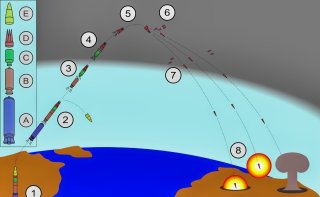Lockheed Martin Scores Massive $17 Billon Deal to Upgrade U.S. Missile Defenses from ICBM Attack
Aerospace and defense giant Lockheed Martin has secured a $17 billion contract from the U.S. Missile Defense Agency (MDA) to develop the Next Generation Interceptor (NGI), which will be used to defend the United States from an intercontinental ballistic missile attack.
Aerospace and defense giant Lockheed Martin has secured a $17 billion contract from the U.S. Missile Defense Agency (MDA) to develop the Next Generation Interceptor (NGI), which will be used to defend the United States from an intercontinental ballistic missile attack.
Lockheed Martin will oversee the development of the NGI as part of efforts to modernize the Ground-Based Midcourse Defense (GMD) program. GMD is administered by the MDA. Operational control rests with the U.S. Army, with support functions provided by the Air Force and Space Force. It consists of a network of radars, interceptors, and other equipment that is all designed to protect the United States from an adversary's ICBMs.
The Interceptor is aimed at defeating current ballistic missile threats and to be capable of adapting to future technological advances from countries including North Korea and Iran.
"Lockheed Martin is proud to partner with the MDA on a revolutionary interceptor to advance our nation's security. We are committed to delivering reliable interceptors that will seamlessly integrate with the GMD system and can rapidly evolve with the threat," said Sarah Hiza, vice president and general manager of strategic and missile defense at Lockheed Martin. "We stand ready to support our customer for decades to come with a solution capable of protecting the nation from current and future threats."
Technology Development Phase
According to Lockheed Martin, the program continues on its path to Critical Design Review, integration with the broader weapon system, and flight testing.
It will transition to product development in May, while the MDA plans to buy 20 interceptors and deploy them at Fort Greely, Alaska. The first interceptor is expected to be operational in 2028
Lockheed Martin for the Win
In testimony to the House Armed Services Committee, Lt. Gen. Heath Collins, director of the Missile Defense Agency, told lawmakers that either Lockheed Martin or Northrop Grumman would be selected as the prime contractor for the NGI – the companies were awarded separate contracts in 2021 to develop designs for the program.
As reported by Reuters, the win could be seen as a shot in the arm for Lockheed Martin after the U.S. Department of Defense announced in February that it would reduce F-35 orders. Meanwhile the Army in February announced it had abandoned development of a Future Attack Reconnaissance Aircraft, a next-generation helicopter for which Lockheed had submitted a design.
The NGI program could be worth about $17.7 billion over its lifetime, according to government estimates.
The Biden administration has requested $28.4 billion for missile defenses in its fiscal 2025 budget.
Author Experience and Expertise: Peter Suciu
Peter Suciu is a Michigan-based writer. He has contributed to more than four dozen magazines, newspapers, and websites with over 3,200 published pieces over a twenty-year career in journalism. He regularly writes about military hardware, firearms history, cybersecurity, politics, and international affairs. Peter is also a Contributing Writer for Forbes and Clearance Jobs. You can follow him on Twitter: @PeterSuciu.
You can email the author: [email protected].


